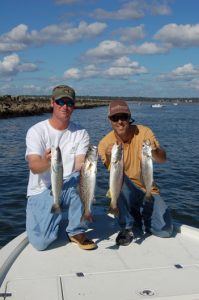Tidelines – Winter 2013-2014

Capt. Kyle Hughes, of Speckulator Inshore Fishing Charters out of Ocean Isle, and Publisher Gary Hurley with a few of the specks and one gray trout they caught on a warm winter morning while floating live shrimp along the south rock wall in the Little River Inlet.
I believe there’s a bell curve when it comes to live shrimping for trout, and I have myself placed at the very top—the most desirable location—of the curve. It’s my bell curve, though, so of course I’m going to place myself at the top. The real question, I guess, is where you place yourself on the live shrimp bell curve?
For me, there are two bottoms to the bell curve—on one side are people who could float a live shrimp all day every day, and on the far other side of the curve are people who have no interest in floating them at all. Then there’s me at the apex of the curve, the place I believe is the best place to be, and it’s that happy medium where you thoroughly enjoy the simple (and productive) pleasures of drifting a live shrimp down a jetty wall or through a current line and could spend all day doing it, but you’d lose interest spending several days in a row adjusting the float depth of your treble hook rig in hopes of finding that “gator” trout.
These reflections on live shrimping came a week ago while fishing with Capt. Kyle Hughes of Speckulator Inshore Fishing Charters out of Ocean Isle. Kyle invited me and a friend down to spend a morning looking for trout on Little River jetties, and our main strategy for targeting these fish would be floating live shrimp down the south side jetty wall at about a 6’ depth.
Me? I had a great time letting line out as my bobber drifted away from the stern of the boat, positioned about 3-4’ off the rocks and getting crushed by something on almost every drift.
My friend Tony? He was a good sport and gave it a try, but soon he wanted to switch over to soft plastics to try and coax a trout to strike.
The soft plastics, Kyle explained, don’t fare that well in Little River Inlet, because in some places if you get more than an arm’s length off of the rocks then you’re into 25’ of water, so it’s hard to keep your lure in such a small strike zone, especially casting perpendicular.
It’s not that Tony didn’t believe Kyle. It’s just that he didn’t care if he caught something or not—Tony’s on that far side of the bell curve where people have little to no interest, the place some call “purist” (and others call “snobbish”).
I, on the other hand, was happy to revisit my childhood that day by plying out line and waiting for the bobber to go down. And go down it did. Kyle put us on speckled trout (up to the 3 lb. class), gray trout, red drum, sheepshead, flounder, and tautog. I basically enjoyed nonstop fishing action on a cool December morning (I think the final tally was three inshore slams that day), and we had a cooler full of tasty fish in the 24’ Triton by lunchtime.
As for those on the opposite side of the curve from Tony? The ones who could drift a live shrimp all day every day? I don’t think I could do it. I think on day two I’d be like Tony and pull out a leadhead and a Z-Man, D.O.A., or Bass Assassin.
Capt. Kyle Hughes can float a live shrimp with the best of them (he watched me catch several modest trout and sheepshead, and then proceeded to catch our biggest trout of the day on his very first drift), but he certainly has other “go to” techniques.
Our run from Little River back to the Ocean Isle public boat ramp included a quick stop in the ICW to play with some “pet” red drum, a school of under-slot pups that aggressively bit on live mud minnows dragged along the bottom. Kyle will target reds and trout through the winter months in canals and marinas, and for those wanting to find a citation-class speck he suggests hitting the Little River rocks in late April or early May (note to self: call Kyle in mid-April).
Speaking of the simple pleasures in life, I’m thankful that I continue to enjoy the simple pleasure of being able to drive to and from my house, a simple pleasure that has currently been taken away from our friends on Hatteras Island.
In yet another blow to the economy and people of the Outer Banks, the NC Department of Transportation closed the Bonner Bridge over Oregon Inlet on December 3. Citing scouring under bridge pilings near the span’s southern end that compromised the bridge’s integrity, the DOT closed the bridge until further notice, turning a short drive into a lengthy ferry ride for residents and others who want to access Hatteras Island (an emergency ferry route from Stumpy Point on the mainland to Rodanthe was put into place the next day).
As of print time, the DOT still hasn’t released a hard date that islanders and visitors will have the Bonner Bridge back.
So until we meet again in March 2014 (the date of our next issue, as we take the winter off to attend boat shows and host fishing schools), be grateful for the simple pleasures in life, whether catching a trout or running a simple errand.
In the meantime, we don’t want any photos of you running errands, but we’d love to get some shots of winter fish…
